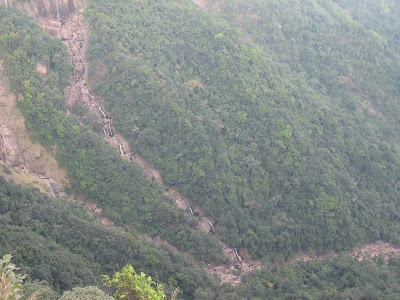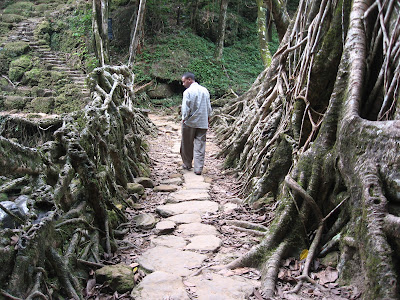In the last week of October of 2010, we were in Meghalaya on a holiday. Even though I hail from a state (Kerala) which has lush green landscape, the verdant valleys of this northeast corner of our country took my breath away.
 |
| Image courtesy: Maps of India |
Meghalaya is one of the seven contiguous states in the northeast of India. These states are a cluster and joined to the rest of India via a narrow corridor (around 20 km at the narrowest section) called Siliguri Corridor.
The seven states are (in clockwise direction) Assam, Arunachal Pradesh, Nagaland, Manipur, Mizoram, Tripura, and Meghalaya. These are popularly called the Seven Sisters of India.
Let us not forget Sikkim (another beautiful place) which is lies north of the corridor, between Bhutan and Nepal. Sikkim, which was a kingdom, joined India in 1975. Many people count Sikkim also as a part of the northeast, though this state doesn't share its border with any of the Seven Sisters.
RAINFALL
We flew from Bengaluru to Guwahati with a stopover at Kolkata. From Guwahati, we took a taxi to Shillong, the capital of Meghalaya.
When I think of Meghalaya, I remember my school geography class. There used to be a popular exam question. Which is the place in India that gets the maximum rainfall. The answer was Cherrapunjee. That's in Meghalaya.
Now Cherrapunjee has been replaced by Mawsynram (also in Meghalaya) which is said to be one of the wettest places in the world, not just in India.
First, we went to a village called Dympep. There are a few locations, which are called "view points", from where we get breathtaking views of the landscape.
 |
| The view from Duwan Sing Syiem View Point, in Dympep, Sohra |
We then went to Nohkalikai Falls (pictured below) in Sohra, Cherrapunjee. It is said to be the tallest water plunge in India, at 340 meters. It wasn't exactly a rainy season when we went there. During the rains, the waterfall is much heavier.
We then went to the Eco Park in Mawsmai, in Cherrapunjee. There are children's play areas, foot bridges, historical monoliths, water conservation structures, besides 'view points', and thick vegetation.
 |
| Above and below, views from Mawsmai. |
 |
| Note the water stream down the hill. |
There is also Mawsmai cave, which has to be approached through thickly wooded paths. Inside the cave one can see fossils. This is not one of those long ones. The longest is Krem Liat Prah which is around 30 km long! I am told nine of the 10 longest caves in India are in Meghalaya and the 10th is in Mizoram.
 |
| On way to the Mawsmai cave |
 |
| Entrance to the Mawsmai cave |
Next, we went to Mawlynnong village. It's so neat and well looked after that in 2003, the Discovery India TV channel ran a documentary and branding the village as the 'cleanest in Asia'. Everyone in the village is educated and the village has made great progress in women empowerment.
Some photos from Mawlynnong below:
Meghalaya is also known for a number of 'living root bridges'. These are not natural formations. They were made by the local people who have learnt how to wrap together thick roots of trees to form these bridges.
The photo above is a close-up shot of one of them. I had a long-shot frame too, but I can't locate it. Give a Google search for "Meghalaya root bridges", and you will find plenty of photos. There are some long ones, that are so strong they can hold as many as 50 people at a time!
(My northeast tour continues tomorrow with another state: the only one of the Seven Sisters whose name starts with N.)
--------------------
This post is part of the blogging challenge in April every year, wherein bloggers put up one post a day, from A to Z, every day except Sundays.
I'm participating in #BlogchatterA2Z. I am also on A2Z April Challenge.





Hari OM
ReplyDelete...and you forgot to mention the name translates from the Sanskrit as "Place of Clouds" - leading to all that precipitation!!! &*> Lush indeed, and your photographs are Mesmerising. YAM xx
M=Messiah
I don't know why, but the idea of root bridges wig me out. I'm sure if I saw one in person, it wouldn't, but the idea of them...
ReplyDeletePretty place. How many states are there in India?
Looks like a lovely place. Never been to that part of India, yet.
ReplyDeleteVery nostalgic for me. I visited these places many times in my youth.
ReplyDeleteMeghalaya is on my bucket list for long nowm what a wildly beautiful landscape
ReplyDeleteFascinating! I love the lush vegetation and water falls.
ReplyDeleteBeth
https://bethlapinsatozblog.wordpress.com/
What a beautiful place, panoramic views of the grand verdant valleys, water fall with highest leap, living root bridges...everything is so amazing here! Adding this to my list of TBV (to be visited).
ReplyDeleteThat living bridge is amazing, and the countryside looks spectacular. The rain seems to be very good for keeping it beautifully green.
ReplyDeleteTasha
Tasha's Thinkings: YouTube - What They Don't Tell You (and free fiction)
Hi Pradeep - I wrote about these in Assam in 2018 ... and how people communicate by whistling across the valleys and gulleys ... and how the bridges keep themselves alive, as they continue growing. What an amazing visit - beautiful scenery ... how high where were you - cheers Hilary
ReplyDeleteThis comment has been removed by the author.
DeleteThis comment has been removed by the author.
ReplyDeleteVery interesting Post.. For people who love traveling and exploring Nature, Meghalaya is one of the prime destinations. Love the narration and the related Photos!
ReplyDelete